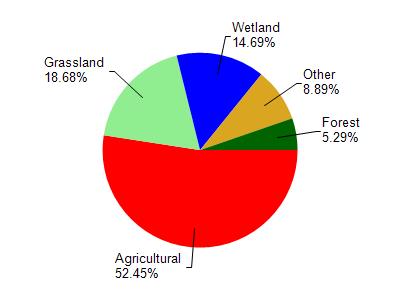
5.37 Miles
3.92 - 9.29
Macroinvertebrate, Cool-Warm Headwater
2012
Poor
Low DO, Degraded Habitat
Total Phosphorus, Sediment/Total Suspended Solids
Dodge
No
No
Yes
Fish and Aquatic Life
Overview
Dead Creek, a tributary to the Rock River at Sinissippi Lake, flows through an extensive wetlands complex that provides good waterfowl habitat. Baseline monitoring data collected in 2001 has not been completely evaluated (as of December 2001). Initial evaluation indicated the stream to be in poor condition. The section from the State Trunk Highway 115 downstream to St. Helena Road should be reclassified to full fish and aquatic life, warmwater sport fishery (WDNR, 1994). Juneau discharges its treated wastewater effluent to the Dead Creek.) In December 2001, the Lake Sinissippi Association and the Lake Sinissippi Management District, with the U.S. Geological Service, installed an automated water quality monitoring station on the creek. Sediment and nutrient loads will be monitored for one year.
Date 2002
Author Aquatic Biologist
Condition
Wisconsin has over 84,000 miles of streams, 15,000 lakes and milllions of acres of wetlands. Assessing the condition of this vast amount of water is challenging. The state's water monitoring program uses a media-based, cross-program approach to analyze water condition. An updated monitoring strategy (2015-2020) is now available. Compliance with Clean Water Act fishable, swimmable standards are located in the Executive Summary of Water Condition in 2018. See also the 'monitoring and projects' tab.
Reports
Recommendations
Water Quality Planning
This grant will provide for the sampling and analysis of water samples taken from stage discharge stations on the West Branch of the Rock River near Waupun, the East Branch of the Rock River near Mayville, the Rock River at Horicon, and the Rock River at Hustisford. The data collected, when combined with previously collected data, will be used to provide a better understanding of sediment and Phosphorus loads entering Horicon Marsh, leaving Horicon Marsh, entering Lake Sinissippi, and leaving Lake Sinissippi.
Management Goals
Wisconsin's Water Quality Standards provide qualitative and quantitative goals for waters that are protective of Fishable, Swimmable conditions [Learn more]. Waters that do not meet water quality standards are considered impaired and restoration actions are planned and carried out until the water is once again fishable and swimmable
Management goals can include creation or implementation of a Total Maximum Daily Load analysis, a Nine Key Element Plan, or other restoration work, education and outreach and more. If specific recommendations exist for this water, they will be displayed below online.
Monitoring
Monitoring the condition of a river, stream, or lake includes gathering physical, chemical, biological, and habitat data. Comprehensive studies often gather all these parameters in great detail, while lighter assessment events will involve sampling physical, chemical and biological data such as macroinvertebrates. Aquatic macroinvertebrates and fish communities integrate watershed or catchment condition, providing great insight into overall ecosystem health. Chemical and habitat parameters tell researchers more about human induced problems including contaminated runoff, point source dischargers, or habitat issues that foster or limit the potential of aquatic communities to thrive in a given area. Wisconsin's Water Monitoring Strategy was recenty updated.
Grants and Management Projects
Monitoring Projects
| WBIC | Official Waterbody Name | Station ID | Station Name | Earliest Fieldwork Date | Latest Fieldwork Date | View Station | View Data |
|---|
| 860000 | Dead Creek | 143232 | Rock River - Juneau Stp | 2/19/1976 | 1/15/1985 | Map | Data |
| 860000 | Dead Creek | 10017188 | Dead Creek-Station 8 Eagle Rd. Downstream Si De. | 5/16/1984 | 5/16/1984 | Map | Data |
| 860000 | Dead Creek | 10017287 | Dead Cr.-Shady Lane Rd Station 7 Just Dow Nstream. | 5/16/1984 | 8/7/2012 | Map | Data |
| 860000 | Dead Creek | 143213 | Rock River - Milbrew Inc Juneau 001 | 2/19/1976 | 5/17/1979 | Map | Data |
| 860000 | Dead Creek | 143214 | Rock River - Milbrew Inc Juneau 002 | 2/19/1976 | 5/17/1979 | Map | Data |
|

Watershed Characteristics
Dead Creek is located in the Sinissippi Lake watershed which is 234.93 mi². Land use in the watershed is primarily agricultural (52.50%), grassland (18.70%) and a mix of wetland (14.70%) and other uses (14.20%). This watershed has 458.18 stream miles, 1,917.70 lake acres and 22,222.24 wetland acres.
Nonpoint Source Characteristics
This watershed is ranked High for runoff impacts on streams, High for runoff impacts on lakes and High for runoff impacts on groundwater and therefore has an overall rank of High. This value can be used in ranking the watershed or individual waterbodies for grant funding under state and county programs.However, all waters are affected by diffuse pollutant sources regardless of initial water quality. Applications for specific runoff projects under state or county grant programs may be pursued. For more information, go to surface water program grants.
Dead Creek is considered a Macroinvertebrate, Cool-Warm Headwater under the state's Natural Community Determinations.
Natural communities (stream and lake natural communities) represent model results and DNR staff valiation processes that confirm or update predicted conditions based on flow and temperature modeling from historic and current landscape features and related variables. Predicated flow and temperatures for waters are associated predicated fish assemblages (communities). Biologists evaluate the model results against current survey data to determine if the modeled results are corect and whether biological indicators show water quaity degradation. This analysis is a core component of the state's resource management framework. Wisconsin's Riverine Natural Communities.
Cool (Warm-Transition) Headwaters are small, sometimes intermittent streams with cool to warm summer temperatures. Coldwater fishes are uncommon to absent, transitional fishes are abundant to common, and warm water fishes are common to uncommon. Headwater species are abundant to common, mainstem species are common to absent, and river species are absent.